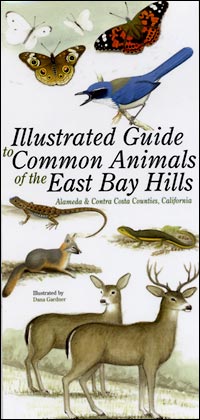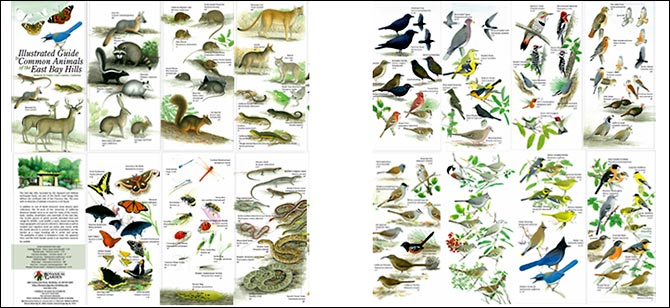Botanical Garden offers illustrated guide to East Bay hills animal life
The UC Botanical Garden has published an illustrated field guide to animals found in the Garden and the rest of the East Bay hills. Researched by two Garden principals, both zoologists, it features close to 125 creatures, including mammals, amphibians, reptiles, birds and insects. An event at the Garden on May 20 celebrates its debut.
May 17, 2011
The UC Botanical Garden’s raison d’être is collecting plant species from around the world for scientific and educational purposes. But as a habitat where food and water are plentiful, and trapping and killing wildlife is verboten, the living museum also has an incidental role as an oasis for wild animals.

Field guide cover
Now, two Botanical Garden principals, both zoologists by training, have created a simple, easy-to-use field guide to animals in the Garden and the rest of the East Bay hills — from the much-celebrated newts found in and around the pond in the Garden’s Asian section to Cooper’s hawks, black-headed grosbeaks and tiny Pacific chorus frogs that populate the trees.
“It’s a recognition that many who come to the Garden, especially kids, are really more excited at first by seeing a wild animal than a plant,” says director Paul Licht, who collaborated with Chris Carmichael, associate director of collections and horticulture, to create the identification tool.
Local artist Dana Gardner did the original watercolor illustrations, which will be on sale, along with the laminated, fold-out guide itself, at a launch party at the Garden on Friday, May 20.
The idea for a faunal field guide was first proposed several years ago. The two zoologists, not surprisingly, were excited about the project, and opted ultimately to include some East Bay hills creatures that the Garden’s fences, by design, keep out.
“We’re part of the total ecology of the hills,” says Licht. “To make the guide more generally useful, we added animals like lions, bobcats and deer.”
Given limited space, not every local critter could be included. Moles didn’t make the cut, nor did some introduced (non-native) species. One of the most common butterflies in the area, the non-native cabbage white butterfly, is shown, notes Carmichael. “We also included the widely introduced multicolored Asian lady beetle” and the honey bee, “which is non-native but rather crucial to California agriculture.”
10 a.m. to 3 p.m., Friday, May 20
at the UC Botanical Garden
2 p.m.: Remarks by Director Paul Licht and Contra Costa Times columnist Gary Bogue
Free with Garden admission.
Calendar listing and map
After pilot testing with kids, the final “Illustrated Guide to Common Animals of the East Bay Hills” showcases close to 125 animals most likely to be sighted on a stroll through the Garden or a hike in one of the regional parks: 10 reptiles, 5 amphibians, 18 mammals, 61 birds, 21 insects and a perennial favorite (if only for the ugh factor) from genus Ariolimax, the banana slug. The guide sells for $8.95.
Recently, Licht notes, infrared-enabled “critter cams,” installed at the Garden as part of a student project, confirmed that “all the usual suspects — wood rats, fox, raccoon, skunk” — are on the move in the Garden under cover of darkness.
Climate change, he speculates, may partially explain the arrival of newcomers to the Garden such as hooded oriole, “which didn’t appear here until a dozen years ago and are now quite common” and American crows, which are now nesting in the trees and are “very formidable predators” of lizards, snakes and small birds.
“We’ve never seen a barn owl or a bluebird,” adds Licht. “But this year — because we’ve given up using all rodenticides and poisons — we’ve put up a barn owl nest box, on the philosophy ‘build it and they will come.’ Barn owls are incredible rodent controllers.”

“Illustrated Guide to Common Animals of the East Bay Hills," front and back fold-out panels.